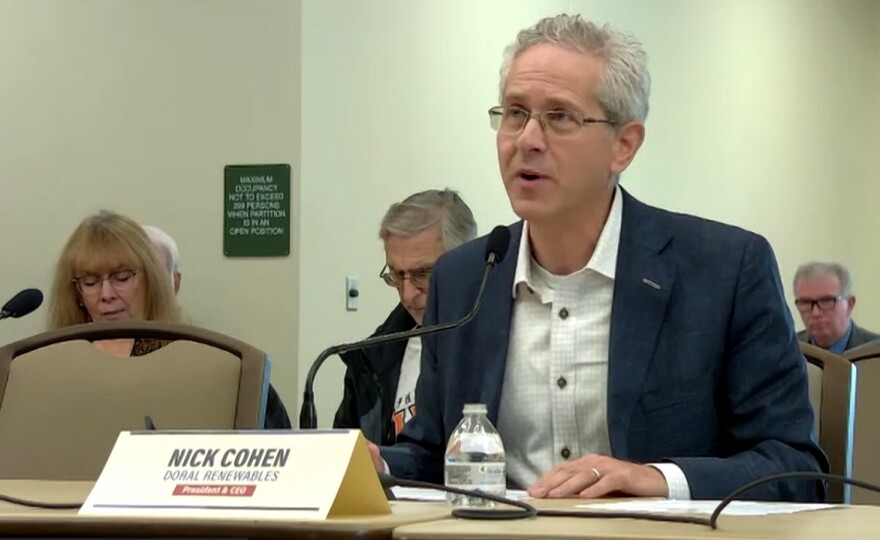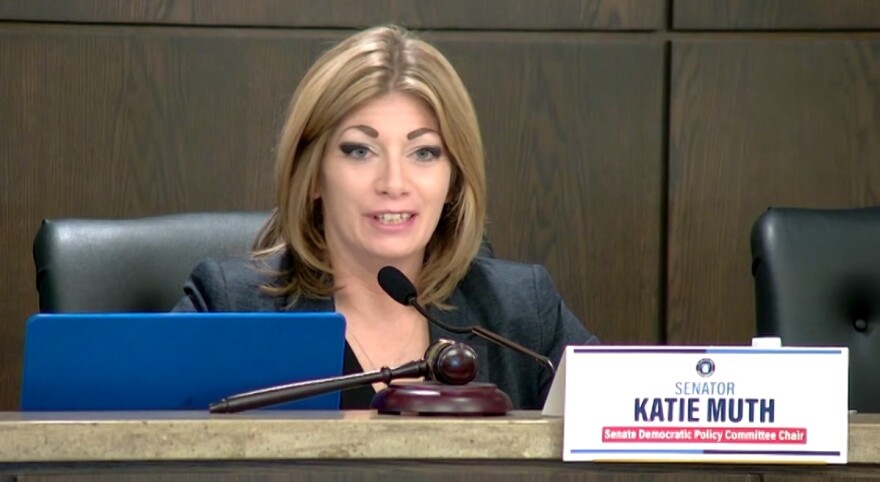EAST VINCENT TWP., Pa. — If energy projects aren’t developed responsibly, with policies and regulations in place, there can be dire consequences, said state Sen. Katie Muth.
“We saw that, we are living it, in the state relative to the oil and gas industry,” said Muth, a Democrat representing parts of Chester, Montgomery and Berks counties. “Other parts of our state have been legacy polluted and are communities of environmental justice, meaning they have some of the worst living conditions relevant to air, water and soil quality, and those communities even need further protection.
“While we all know we need energy to do the things we need to do on our life — drive, turn on the oven, turn on the lights — there needs to be a dramatic shift in our mentality towards what can we do to generate the least amount of emissions with the least amount of waste and the least amount of harm.”
Muth, along with other state legislators, on Monday held a committee hearing titled, “Minimizing Risk & Harm: Preparing for Pennsylvania’s Hydrogen Future” at the East Vincent Township Building, 262 Ridge Road, Spring City, Chester County. It comes almost two months after President Joe Biden announced seven regional clean hydrogen hub projects, including two in Pennsylvania, would receive $7 billion in Bipartisan Infrastructure Law funding to accelerate the domestic market for low-cost, clean hydrogen across the country.
While neither hub is situated in the Lehigh Valley, area residents could still be affected — especially when it comes to jobs and reducing emissions.
“We need to know: How will this roll out? What does this look like? And, what can local and state governments do to protect the residents as these dollars are distributed and the plans continue to be more finalized?”Pa. Sen. Katie Muth
Featuring two panels, the almost-three-hour-long hearing included testimony from experts in renewable energy, researchers and environmental advocates. While several who testified said that hydrogen energy would be best suited for niche industrial work, others warned of the dangers of hydrogen if applied to residential utilities.
“It's your money, the people's money that is funding all of these projects,” Muth said. “So, not only is this going to impact your quality of life, down to possibly even what comes to power your utilities in your home.
“We need to know: How will this roll out? What does this look like? And, what can local and state governments do to protect the residents as these dollars are distributed and the plans continue to be more finalized?”
Blue vs. green hydrogen
Pennsylvania is the only state to be included in two hydrogen hub projects, the Mid-Atlantic Hydrogen Hub, or MACH2, based around Pennsylvania, Delaware and New Jersey, and the Appalachian Hydrogen Hub, or ARCH2, in West Virginia, Ohio and Pennsylvania.
MACH2 was awarded up to $750 million, while ARCH2 got up to $925 million.
While the former would be creating “green” hydrogen, which involves using renewable energy sources, like solar panels, the latter is expected to produce “blue” hydrogen, or hydrogen produced mainly from natural gas. It’s described as “blue” because, while it involves using fracked natural gas and can produce harmful carbon dioxide emissions, there's a plan to capture those emissions before making their way into the atmosphere.
To create “green” hydrogen, energy from sun or wind “essentially blitzes water with electricity,” said Nick Cohen, president and CEO of Doral Renewables, a Philadelphia-based renewable energy company.
“And you get your hydrogen and the other byproduct is oxygen,” he said. “It's very clean, it's very easy to follow and it makes a lot of sense. We just need to make sure that we have enough green energy, green renewable energy to accomplish this — but the science is there.”

However, making sure the state has enough renewable energy could be tough.
“Right now, Pennsylvania only has 3% renewable energy, and the rest is from other sources, mostly carbon-based,” said Cohen. “So if you want to make green hydrogen, you have to have green renewable energy.”
In 2021, renewable energy sources generated 3% of electricity statewide, according to the U.S. Energy Information Administration.
“The science and the practices need to be proven at scale in order for the public to accept blue hydrogen as a clean source,” Cohen said. “Academically speaking, it makes a lot of sense. We have a lot of natural gas; there's an infrastructure in place.
“But there's a lot of carbon dioxide that comes off of the process of making blue hydrogen, and it's only clean blue hydrogen if you can sequester all that [carbon dioxide].”
There are too many alternatives — like clean electricity — for Cohen to think hydrogen will become a main source of energy.
“I don't see a scenario where suddenly we become a transportation society based on hydrogen, especially when electric cars are getting a lot of traction and they're so efficient,” he said. “Hydrogen right now is mostly used in refining and ammonia production and some chemicals.
“I do think that it will continue to be nichey for chemicals and what I would call elemental uses — that's where it makes the most sense.”
‘Worse than from simply burning natural gas’
The second, and final, panel of the hearing was focused on the public health and safety implications of hydrogen hub projects.
Robert Howarth, a professor of ecology and environmental biology at Cornell University, said using “blue” to describe hydrogen made from natural gas is deceptive — it’s just “gray” hydrogen under a new name.
“Blue hydrogen is a new concept, an idea that came out of the marketing forces of the oil and gas industry and widely promoted through the Hydrogen Council, an organization established in 2017 by several big majors in the oil industry — BP, Total, Shell, etcetera,” Howarth said during his testimony. “The Hydrogen Council and others in the oil and gas industry have often described blue hydrogen as having low or zero greenhouse gas emissions. This is simply not true.”
In August of 2021, Haworth, along with Stanford University’s Mark Jacobson, published a peer-reviewed analysis of the greenhouse gas footprint of blue hydrogen.
“Our conclusion is that while greenhouse gas emissions from blue hydrogen are somewhat less than those for the traditional gray hydrogen made from natural gas, they are substantially larger than if one were to simply burn natural gas instead,” he said. “ … The bottom line is that blue hydrogen is a climate disaster. Greenhouse gas emissions are worse than from simply burning natural gas.”
While utilities may advocate for blending hydrogen and natural gas to meet emissions targets, the environmental benefits are almost non-existent, said Megan McDonough, Pennsylvania state director of Food & Water Watch, a Washington, D.C.-based agency that focused on corporate and government accountability.
“For instance, a 5% blend of hydrogen results and a mere 2% reduction in natural gas use of power plants,” he said. “Even a 20% blend — the highest currently considered — only marginally reduces carbon dioxide emissions by 6.5%.
“Moreover, the existing gas grid, already plagued by leakage issues, is ill equipped to handle hydrogen.”
Aging pipes can leak, and leaks disproportionately impact non-white and lower income communities, she said.
“Hydrogen being leakier than natural gas substantially heightens the likelihood of pipeline blowouts and explosions,” McDonough said. “Unlike natural gas, hydrogen cannot be easily detected, amplifying the risks to health and safety. Even small amounts of hydrogen pose significant risks to those using gas in their homes or living near gas storage facilities and pipelines.”
Upgrading the gas infrastructure for a hydrogen mix is going to be expensive — and paid for by residents.
“Molecularly, [hydrogen is] smaller, which means it leaks more and can't be easily smelled with no known odorant that can actually travel with it,” she said. “Hydrogen is also 14 times more flammable than natural gas, so chances are it will be missed, it would probably be missing until it's too late, putting our home and neighborhoods at risk.
“It's really like having a silent intruder in your house or neighborhood. And if we simply apply common sense to this issue, we get to the right answer on whether this new scheme should be supported or not.”


